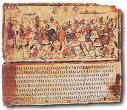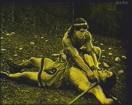Homer's "The Iliad"
Note: The textual discussion will take place in class... text notes are not online.

Notes on “The Iliad”
Names in the text:
Acheans: the principle peoples of ancient Greece
Achilles: greatest Greek warrior of Trojan war; son of Peleus and Thetis.
Myrmidon: elite sector of forces that Achilles led.
Patroclous: beloved friend and companion of Achilles.
Helen of Troy: daughter of Zeus and Leda; most beautiful woman of the age; marries Menelaus, the King of Sparta.
Agamemnon: King of Mycenae and Argos; commander of GK forces.
Priam: father of PARIS and HECTOR; had over 100 children: last King of Troy.
Briseus: a Trojan girl, a war prize for Achilles that Agamemnon wants.
Chryseis: captured priest of Apollo.
Nestor: wise old king, counselor to Agamemnon.
Hades: house of hell, underworld.
Dionysus: god of wine and revelry; Apollo: god of fine arts, medicine, poetry, & eloquence.
Zeus: most powerful of all ancient GK gods; ruler of heaven and earth and all men.
Hephaestus: deformed, lame god of metalworkers. Son of Zeus and Hera, husband of Aphrodite, father of Eros.
Odysseus: His adventures are recounted in “The Odyssey”.
Ilium: another name for Troy—thus, “The Iliad”.
-“The Iliad” has 15,693 lines of verse. It is the greatest epic of Western Civilization. Homer’s works have influenced every subsequent century, and you will see references to “The Iliad” in many other readings. It is, unsurpassed, the greatest war story ever told… but it may also be among the greatest love stories as well…
Myths NOT relevant to “The Iliad”:
-Achilles’ vulnerable heel & the myth of the river styx.
- The Trojan Horse (the actual attack isn’t mentioned in ‘The Iliad’).
- Myth of Helen’s suitors vowing support for her husband.
- Agamemnon sacrificing his own daughter to appease Artemis.
TRUTH of the story:
-There was a great city built on the site that attributed to “Troy”, and it was indeed destroyed around 13th century B.C.
-Homer lived after the historical events, so he is reporting on a time past.
-While the story is part myth, part history, the heroes of the story were very real to the Greek people.
- GKS recognize a structure in Asia Minor as the burial mound of Achilles & Patroclous.
- GKS trace their ancestry back to the heroes of Homer’s poems.
"The Iliad" is an Epic Poem:
Characteristics of an Epic:
1- an extraordinary hero is charged with a quest 2- the quest has obstacles 3- supernatural element 4- at the hero’s low point, he resurrects himself
Epic Poem: a long narrative poem detailing the adventure or journey of a hero.
Epic Hero: larger than life, but human… more than an “everyday man”. MALE. He is rewarded spiritually upon death.
1. He has unusual circumstances of birth
2. An event (or trauma) leads to a quest
3. He gets supernatural help
4. He must prove himself
5. He is rewarded upon death
Epic Conventions: 1- invocation 2- epic question 3- Homeric simile 4- epithet 5- confrontation b/w 2 adversaries 6- “in media res”—begins in the middle of action 7- Combat
The journey is the key element in the Epic Cycle.
5 Elements of the journey: 1. The quester (Achilles) 2. A place to go (Troy) 3. A reason to go (Revenge) 4. Challenges/Trials (Hector/Agamemmnon/Priam) 5. the REAL reason (Guilt & Heartbreak) -- You can apply to "Gilgamesh" as well.
Talk about the story in relation to the above.
THEMES:
- The interaction between fate and free will: human choice versus the will of the gods.
- Love & hate: Achilles displays overwhelming passion for both: Patroclous—Agamemnon/Hector.
- Pride: Unlike in Christian tradition, where pride is seen as a vice, GKS saw pride as a source of greatness.
- Pursuit of Glory: emphasis on THIS LIFE… a hero must win glory to be remembered here on earth… no comfort in the afterlife.
- Glory of Battle/Horror of War: (List your own examples)
- Grief and Revenge: (List your own examples)
- Male-Male bonds: We can trace certain behaviors and emotions between men who show affection for one another in the story: Agamemnon/Menelaus; Hector/Paris; Hector-Paris-Priam; Achilles/Priam; Achilles/Patroclous…
- Homosexuality, or more correctly, “paiderastia”, a Greek word meaning, “boy love”. Achilles’ love for Patroclous is the crux of the entire story.
“Paiderastia” was usually a relationship between an older and a younger
male (age 14-20). The older man was called “erastes”, younger, “eromenos”. It was a give and take relationship; the older was a role model, educating, protecting and loving the younger male, who would in turn give his partner beauty and youth.
How Achilles/Patroclous fit these roles is unclear—they both contain
characteristics of “erastes” and “eromenos”. MOST scholars support the reading
of “The Iliad” as a homosexual text, and many translations are more overt about
this connection (as being sexual) than the one in our textbook. However, it is
important to note that in Greek culture, there was never any doubt that this was the
nature of their relationship.
* While Christianity brought a change in the public’s outlook on “sex” and “sin”, Greek culture encouraged sex—and same-sex bonds. In fact, homosexual bonds were thought of as conducive to bravery and military valor. Heterosexual unions were, at the same time, mandated, to increase the population. However, it is also important to note that there was a distinction between a relationship desired by both parties, even when one partner was young, with pedophilia: forced intimacy with a child that hasn’t reached puberty—a crime, even back then. This is totally unrelated. Life expectancy was much shorter then than it is now, and both women and men became sexually active at the start of puberty.
Instructor’s Note: Some of the most beautiful and touching lines in the poem are when Achilles is agonizing in grief over the lost of his beloved companion. It teaches us that unconditional love doesn’t come with preconditions. It is one of the most passionate and powerful love stories in all of literature.
Women in Ancient Greece:
*Greece was a patriarchal society.
*Women married at a young age, often to older men. Their primary function was to bear children. They were the property of men. The mistress of the house was always the husband’s mother… women were often confined to their homes.
*An exception to this was the women of Sparta. They were equal; they were educated, owned land, and could have multiple husbands (men could of course have multiple wives). They also were able to participate in public life.
* In Athens, women were often locked away in her quarters to keep her from temptation; it was important that a man know that all of his wife’s children were his. If she were caught with a lover, he could be killed. In Sparta, a woman could bear another man’s child if her husband proved inadequate.
Sex in Ancient Greece:
Sexual orientation was not social identifier to them. Gender was not important; social status was. Partners were either dominant-- active or passive; the active role was associated with masculinity, high social status, and adulthood; the passive role was associated with femininity, lower social status, and youth. These social inferiors could be women, young men, foreigners, prostitutes (looked down upon by the Greeks because they didn’t see it appropriate to use sex for financial gain), or slaves. The dominant partner was always the “penetrator”. Homosexual eros was so important to the Greeks that even Sparta had homosexual relationships built into the training of their young men.
Male-male relationships are central to the history, warfare, politics, art, literature, and learning of Greece. They were warm, loving, affectionate, respectful relationships. However, these relationships were seldom “equal” partnerships… the roles were still intact—passive and active; erastes and eromenos.
Because of these prescribed roles, “The Iliad” has perplexed scholars for centuries. While it is clear that Achilles and Patroclous are the “pederastic icons” of ancient Greece, their roles are hard to define. Homer says that Patroclous is older, and he emphasizes Achilles’ beauty; however, Achilles seems dominate in the relationship.
Marriage
-No specific ceremony, but the couple regarded each other as "married". Men were in their 30's, women in their teens. This age structure held true for same-sex relationships.
- Romans had no strict age structure, except that the the man was older than the woman-- but how much older didn't matter. Women had more rights during the Roman Empire than Greek women did. In the early days of the Roman Empire, men could be legally married to one another. It wasn't until 390 that Christian Emporers Valentinian II, Theodoisus and Arcadius declared homosexual sex to be illegal and decided that if caught, the "guilty" could be burned alive in public. Imagine how different our views of sex and sexuality would be today had a dictator not decided this for us.
-In the Early Christian Era, mariage was a private matter, and no religious ceremony was required. Until 1545, marriage was just "mutual consent" and a subsequent physical union of the parties. It was a verbal promise, no witnesses necessary. Sex automatically was a binding "marriage".
-Many changes in marriage "laws" or "trends" occurred throughout the Middle Ages. Some churches began to record marriages as part of their records. Laws changed regarding the age of a woman to marry-- from 24 to 20... by the late 15th century, the average age that a woman married was 25. Roman Catholic marriages, after the Council of Trent in 1545, as part of the Counter-Reformation, would only be recognized if the marriage was officiated by a priest with 2 witnesses. The defintion of "marriage" as being between a "man and a woman" was only created in 1566. State-involved marriage came later, in the 1600's.
Today, the concept of "marriage" differs from region to region. For example, gay marriage is legal in Denmark, Netherlands, Belgioum, Spain, Canada, South Africa... and polygamy, which is looked down upon in America, for example, is commonplace in parts of Africa. Arranged marriages are also the norm in some cultures. Attitudes toward marriage and sex are ever-changing and are subject to social climates. Taboos and stereotypes regarding sex and marriage are created by societies.
t 6:40pm on February 6, 2010, Hollie Domingue said… http://www.youtube.com/watch?v=mffUNXHjcHQ
Achilles and PriamDelete Comment At 6:38pm on February 6, 2010, Hollie Domingue said… http://www.youtube.com/watch?v=hf4IoxEUmHM
Hector vs. AchillesDelete Comment

